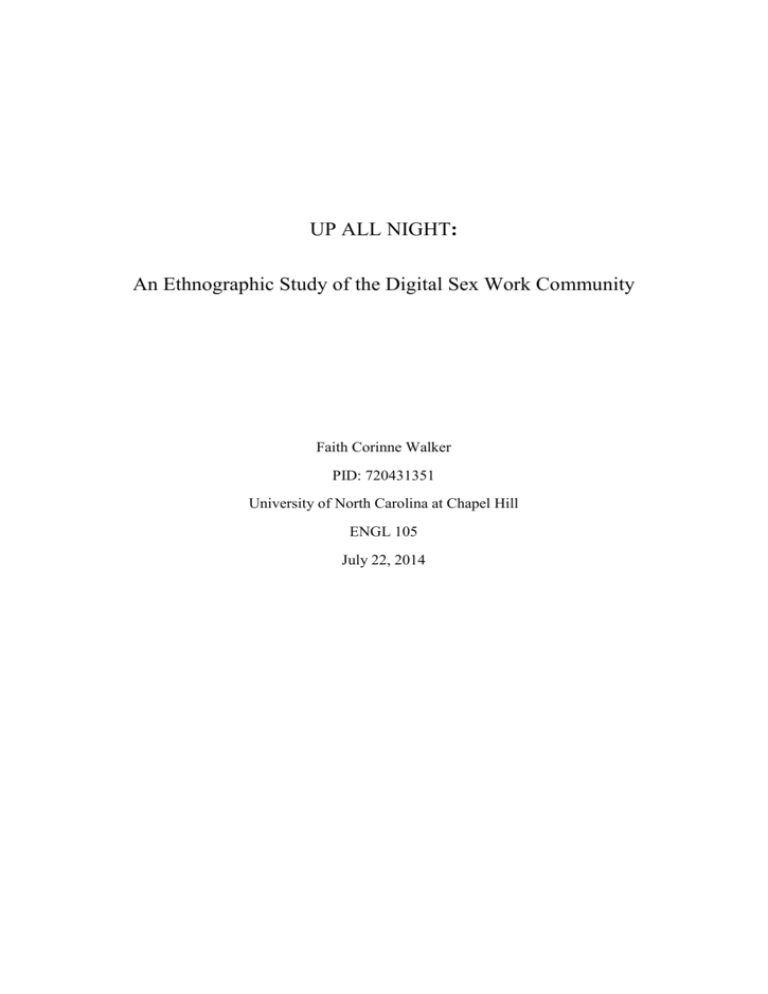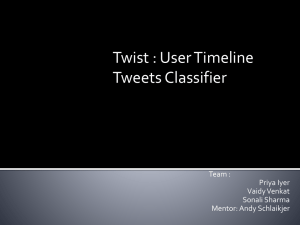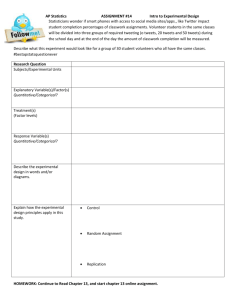this example
advertisement

UP ALL NIGHT: An Ethnographic Study of the Digital Sex Work Community Faith Corinne Walker PID: 720431351 University of North Carolina at Chapel Hill ENGL 105 July 22, 2014 UP ALL NIGHT: An Ethnographic Study of the Digital Sex Work Community Introduction: When thinking of the typical social media site, be it Facebook, Twitter, Instagram, or the plethora of others, the default vision is not a dashboard full of mature photos, updates, and links to raunchy, not-safe-for work content. However, this is the reality as many budding and established sex workers, such as strippers, escorts/call girls, and phone sex operators (PSO), self-promote their services and publicize their personal lives and struggles to the web. Though the stereotypical image of such “deviant behavior” is often constrained to spaces such as topless bars and “massage parlors”, in recent years, many sex workers have been turning to the Internet in hopes of bringing in more clients and, ultimately, more revenue. These non-socially conforming individuals also populate their own online forums, blogs, and work-specific sites which allow them to have a greater sense of community to chat about the positive, lucrative aspects of sex work. In addition, these same online sites act as safe spaces that allow them to console and support fellow workers facing negative backlash, which includes heavy stigmatization, client troubles, outings to family and friends, and political pressure. In this paper, I will be analyzing and presenting this interconnectivity by using tweets from social-media giant Twitter, from users tagging their updates with #sexwork. Methods: The original data set of tweets contained 1,528 unique tweets, captured between Wednesday, July 2nd, 2014 and Sunday, July 6th, 2014, was collected using the dataharvesting Twitter Archiving Google Spreadsheet (TAGS) tool and transposed to an Excel datasheet to be analyzed and coded.. Before coding the data, it had to be reduced from the original data set of 1,528 tweets into a more suitable sample size of approximately 250. The sample size appeared sufficient as it was in the popular size range of 200 to 300 cases amongst the many studies reviewed in secondary research. To begin, the user language filter 2 UP ALL NIGHT: An Ethnographic Study of the Digital Sex Work Community of the spreadsheet was used to remove all instances of languages other than English using the filter keywords “en.” This simple filter reduced the original number minimally, taking the total from 1,528 to 1,501 relevant tweets. Next was the attempt to eliminate all instances of retweets by applying the text filter ‘begins with - “RT”’ to the column containing the body of the tweet. While this eliminated the majority of retweets, several which had the “RT” embedded in the middle or at the end of the tweet were unfiltered, requiring manual deletion. This second filter led to the greatest reduction in tweets, narrowing the previous 1,501 tweets to a slim 867. The last filter which was applied, the one which ultimately tapered the remaining 867 tweets to approximately 255, was a modest time block from Friday, July 4th to Sunday, July 6th. This time period was specifically blocked off in the belief that the weekend would be a peak time for general Twitter activity, and even more so for this particular community, which appeared to be confirmed by a general consensus via various high-traffic, StripperWeb archived forum conversations(StripperWeb, July 2011). After applying all of the principal filters, a more detailed manual filtering was performed, including removal of tweets only comprised of hashtags, tweets which were community irrelevant, and “@username(s)”only tweets. This brought me to my final total of 218 tweets. After having handled the data thoroughly during the cleaning process, a sense of familiarity with the data allowed coding to begin using these categories: 1. Politics, in which the subject matter is focused on the policies and general political matters which are affecting the community, including any mentions of international rights groups (i.e., amnesty international), local government (Canadian government especially), bills and laws (i.e. #c36), or formal political debates. 2. Connectivity, which encompasses all informal posts detailing the everyday lives of those in the community, including humorous posts, life updates, etc. 3 UP ALL NIGHT: An Ethnographic Study of the Digital Sex Work Community 3. Public Code Frequency Discussion, 13 21 Politics where the tweet links Personal taped 20 Public Discussion SW Conversation to live or 4 98 6 Article Misc 53 discussions about sex work, or relays any information about location, time, or specific subject matter of future public discussions and talks. This is separate from political debates and similar table talks as it is more open to the public with a more informal atmosphere. 4. Sex Work (SW) Conversation, which is comprised of conversation amongst sex workers and informal discussion with non-sex workers. Most tweets in this category include general life updates, airing grievances about clients, and general #sexworkerproblems. 5. Article, which corresponds to any current news stories relating to or involving sex work, as well as academic journal and magazine links. 6. And finally, misc., a collection of tweets that, while topically relevant, were too few to justify their own separate categories. This includes tweets linking to sex workbased art and exhibits, advertisements for workers, promotions, photos, Q&As, signal boosts, and reviews. Discussion: From reviewing the initial codes, one can see that the majority of individuals whouse the tag #sexwork are mainly supporters of those in the community who are politically involved, making up approximately 46.4% of total tweets, or 98 tweets (See Figure A). More UP ALL NIGHT: An Ethnographic Study of the Digital Sex Work Community specifically, the politically-based tweets appeared to focus on the social well-being of “indoor prostitutes,” referring to escorts/call girls and brothel workers, and street-level prostitutes in Canada, which was being negatively affected by the bill #c36. Many of these tweets displayed a strong communal bond against the bill which was described by many of the protesting sex workers as being #patriarchal and #sexist. This garnered a rally cry from a substantial number of workers and supporters including user @CDNSWAlliance who used the community to “Keep your support system close. In Solidarity. #RightsNotRescuse”. The tag #rightsnotrescue, combined with the other aforementioned tags coincided heavily with the #sexwork tag. This is no coincidence, however, as many proponents of the bill support a stigmatizing view of sex work known as the oppression paradigm explained in Weitzer’s (2009) paper, Sociology of Sex Work. This paradigm states that “sex work is the quintessential expression of patriarchal gender relations…that exploitation, subjugation and violence against women, are intrinsic to and ineradicable from sex work” (214). However, this is completely contrary to how many in this field feel about the work. One can observe from the intense live-tweeting and debating of non-sex workers and workers via Twitter during the formal debate held by Canadian government officials that they do not need protecting from the ever present risks that will always accompany the work, but from the laws which allow these risks to inflate by “pushing … workers into unsafe neighborhoods and [subpar] working conditions” (@CDNSWAlliance, Jul.4th). This strong community backlash against the government breaks the traditional mold of women submissive in a patriarchal world for women whom are proud to display their sexuality and need more protective rights to do so. Comparatively, tweets within the community which were strictly personal or conversational only comprised 25.1% (53 tweets) and 9.5% (20 tweets) respectively, leading me to believe that most discussions, as well as other interactions, occur in informal, more 5 UP ALL NIGHT: An Ethnographic Study of the Digital Sex Work Community personal settings. Though the specific set of tweets collected did not yield many personal tweets, in part to the political debate, StripperWeb.com, one of the largest forums on the internet for all variations of sex workers yielded an interesting view into the social and professional lives of the workers. This became surprisingly clear as secondary research revealed sex worker-specific forums and sites for not only clientele gossip, but tips on making more per hour, safety tips, job listings, and a myriad number of other resources just for the workers. A general overview of the forum shows a tightknit community where veterans give newbies great introductory advice as seen in the newbie board, local groups plan to get together to take over strip clubs, and escorts share juicy gossip about getting the most out of their clients. One could see this bond as a strange occurrence because every friend is also an actual or possible competitor who could take away work at any time they wish with a lower price or subjectively better offer. However, as studied in Tibbals’s (2013) Sex Work, Office Work, the social networking found in the sex industry is driven by the high stigmatization of the work, which makes workers gravitate towards others with this same issue and “resembles the [same occurrences] that shape other formal and informal economies” (31). However, this is not to say that all sex workers are viewed equally amongst one another. When browsing these forums, it is very easy to see the hierarchy (or whorearchy as some forum users refer to it) which has been forming since the rise of the sex industry in the 1970s. Charlotte and Kat, both current sex workers and co-editors of the sex work positive site TitsandSass.com, elaborated on this social phenomenon during an interview with Bitch magazine. “There are legitimate distinctions and then there are mean-spirited hierarchies,” Charlotte states, “[and] every time we insult another sex worker because she’s doing her work ‘wrong’, we make it that much easier for people to denigrate us too” (2011). From Charlotte’s article on TitsandSass titled “Sex Work Snobbery” she elaborates on this classist structure of the sex worker realm. She discusses in detail the infighting that comes up within 6 UP ALL NIGHT: An Ethnographic Study of the Digital Sex Work Community the community, for example the “porn star vs. prostitute rift” and the experiential differences and commonalities between massage parlor girls and escorts, and its negative affect on the how outside media and society views these individuals. The tone of the paper suggests that these girls, while comrades, often look down on each other because of the difference in labor dynamics, workplace ethics, and virtues (2011). This same idea can be found in Weitzer’s (2009) Sociology of Sex Work study, though it focuses mainly on the social status differences between indoor (escorts/call girls, brothel workers) and street-level prostitution, he also highlights what is akin to stratification of sex work, where girls with the least sexual contact (PSO, camgirls, strippers) are at the top, and girls with more (escorts, parlor, and the lowest being street-level) are towards the bottom (216-217). Social ladder climbing in these ranks is scarce, most moves being lateral. For example a PSO may consider becoming a camgirl as the exposure would be the same, but never an escort. This idea of lateral or only downward movement is confirmed by Weitzer’s Sociology study in which he observed street-walkers transitioning to peep-shows (a lateral move) or a parlor girl moving at an escort agency (downward) (222). This shows that while a community exists and the general camaraderie is overwhelmingly present, like any other social group there are cliques and a definite social order. Additionally, formal community discussions only covered 2.8% of all tweets.Articles, a very prominent form of communication and awareness within the twitter community with a total of 10% (21 tweets) of the total 211. Interestingly, many of the articles were not only news sources to current sex worker news, but also to numerous peer-reviewed, academic studies and a few large, open source databases such as those found in @SexWorkResearch’s tweet supporting #openaccess and #openscience. This opening up of research to the general public, especially on such an open medium like Twitter, allows the greater masses to see objective views and expand their critical, preexisting views about sex work and sex workers. Finally, the last category Misc. had a small contribution 6.2% (13 tweets). These 7 UP ALL NIGHT: An Ethnographic Study of the Digital Sex Work Community miscellaneous tweets indicate that even within very niche, focused communities there is still some noise and randomness in tweets that, while relevant to the community, is distracting from more substantial and informative updates and posts. Conclusion: In conclusion, the sex worker community is still a complex and self-preserving, full of intelligent, independent individuals whose group is one that is not easily understood, or joined by outside forces. These tweets and forum posts have shown that even groups that live their lives far outside the societal norm are human with emotions and weaknesses like any other common individual. As explained in Deshotels and Forsyth’s (2006) paper Strategic Flirting and the Emotional Tab of Exotic Dancing, while many of the workers exhibit emotional drainage and are often times unable to find authentic versions of their sexual selves, they nonetheless enjoy the work, “the power they [feel]…manipulat[ing] customers”, “empowerment”, and “control of [their] sexuality” (232-233). These women are experiencing the opposite of the normal constraints women feel in not only the work place, but in everyday life. They are reversing the power structure in way that grants them an autonomy that they otherwise would not have, sharing it with one other and building even greater structures to withstand the stigmatizing critique of ‘normal’ society. Though these tweets and forum posts give a great generalized idea of the social aspect of the sex worker community as a whole, much more research is needed in terms of analyzing this hierarchy that is observed in the community by the workers themselves, but not by outside researchers. By studying the inner workings of profitable, niche communities like these, we can not only learn more about what makes these tightknit communities so successful and thriving, but also how humans bond with even the most taboo of connections. 8 UP ALL NIGHT: An Ethnographic Study of the Digital Sex Work Community 9 UP ALL NIGHT: An Ethnographic Study of the Digital Sex Work Community Sources Cited Forsyth, C. "Strategic Flirting And The Emotional Tab Of Exotic Dancing." Deviant Behavior 27(2), 223-241. doi: 10.1080/01639620500468600 Petro, M. (2011, October 26). The H-Word: Q & A with Tits and Sass!. . Retrieved July 21, 2014, from http://bitchmagazine.org/post/the-h-word-q-and-a-with-tits-and-sass Shane, C. (2011, October 31). Sex Work Snobbery. . Retrieved July 21, 2014, from http://titsandsass.com/sex-work-snobbery/ Tibbals, C. (2013). Sex Work, Office Work: Women Working Behind the Scenes in the US Adult Film Industry. Gender, Work & Organization, 20(1), 20-35. doi:10.1111/j.14680432.2010.00552.x Weitzer, R. Sociology Of Sex Work. Annual Review of Sociology, 35, 213-234. doi: 10.1146/annurev-soc-070308-120025 10 UP ALL NIGHT: An Ethnographic Study of the Digital Sex Work Community Reflection While editing my essay, I found that for the most part, I can really use a lot of refinement when it comes to my grammar and punctuation. A lot of the errors I made were relatively careless and can easily be fixed with closer review. Content wise, I discovered that adding a few more quotes directly from the community that I was observing added more credibility in a sense. I was able to confirm what researchers were deducing based on actual observations that people of the community also found. This paints the articles as being slightly more credible and plausible as a normal individual can find relatively similar and unbiased data themselves. Overall, I felt that my paper was very strong in its first submission, but now will be just slightly more improved, grammatically correct, and more comprehensible. 11








